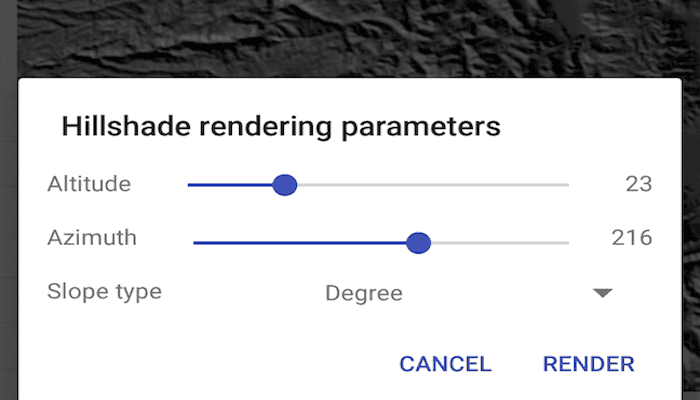Apply a hillshade renderer to a raster.

Use case
An environmental agency may track coastal erosion by comparing images of an area taken over a longer period of time with hillshade renderers applied.
How to use the sample
Choose and adjust the settings to update the hillshade renderer on the raster layer. The sample allows you to change the Altitude, Azimuth, and Slope Type with controls found by tapping the wrench icon at top right.
How it works
- Create a
Rasterfrom a grayscale raster file. - Create a
RasterLayerfrom the raster. - Create a
Basemapfrom the raster layer and set it to the map. - Create a
HillshadeRenderer, specifying the slope type and other properties. - Set the hillshade renderer to be used on the raster layer with
rasterLayer.setRenderer(renderer).
Relevant API
- BasemapStyle
- HillshadeRenderer
- Raster
- RasterLayer
Offline Data
- Download the data from ArcGIS Online.
- Extract the contents of the downloaded zip file to disk.
- Open your command prompt and navigate to the folder where you extracted the contents of the data from step 1.
- Push the data into the scoped storage of the sample app:
adb push srtm-hillshade /Android/data/com.esri.arcgisruntime.sample.hillshaderenderer/files/srtm-hillshade
Tags
altitude, angle, azimuth, raster, slope, visualization
Sample Code
/*
* Copyright 2017 Esri
*
* Licensed under the Apache License, Version 2.0 (the "License");
* you may not use this file except in compliance with the License.
* You may obtain a copy of the License at
*
* http://www.apache.org/licenses/LICENSE-2.0
*
* Unless required by applicable law or agreed to in writing, software
* distributed under the License is distributed on an "AS IS" BASIS,
* WITHOUT WARRANTIES OR CONDITIONS OF ANY KIND, either express or implied.
* See the License for the specific language governing permissions and
* limitations under the License.
*
*/
package com.esri.arcgisruntime.sample.hillshaderenderer;
import android.os.Bundle;
import android.view.Menu;
import android.view.MenuInflater;
import android.view.MenuItem;
import androidx.appcompat.app.AppCompatActivity;
import androidx.fragment.app.FragmentManager;
import com.esri.arcgisruntime.layers.RasterLayer;
import com.esri.arcgisruntime.mapping.ArcGISMap;
import com.esri.arcgisruntime.mapping.view.MapView;
import com.esri.arcgisruntime.raster.HillshadeRenderer;
import com.esri.arcgisruntime.raster.Raster;
import com.esri.arcgisruntime.raster.SlopeType;
/**
* A sample class which demonstrates how to use a hillshade renderer on a raster layer.
*/
public class MainActivity extends AppCompatActivity
implements ParametersDialogFragment.ParametersListener {
private MapView mMapView;
private RasterLayer mRasterLayer;
private int mAltitude;
private int mAzimuth;
private double mZFactor;
private SlopeType mSlopeType;
private double mPixelSizeFactor;
private double mPixelSizePower;
private int mOutputBitDepth;
private FragmentManager mFragmentManager;
@Override
public void returnParameters(int altitude, int azimuth, SlopeType slopeType) {
// gets dialog box parameters and calls updateRenderer
mAltitude = altitude;
mAzimuth = azimuth;
mSlopeType = slopeType;
updateRenderer();
}
@Override
protected void onCreate(Bundle savedInstanceState) {
super.onCreate(savedInstanceState);
setContentView(R.layout.activity_main);
// set default values for HillshadeRenderer parameters
mAltitude = 45;
mAzimuth = 315;
mZFactor = 0.000016;
mSlopeType = SlopeType.NONE;
mPixelSizeFactor = 1;
mPixelSizePower = 1;
mOutputBitDepth = 8;
// retrieve the MapView from layout
mMapView = findViewById(R.id.mapView);
mFragmentManager = getSupportFragmentManager();
// create raster
Raster raster = new Raster(getExternalFilesDir(null) + getString(R.string.hillshade_raster_name));
// create a raster layer
mRasterLayer = new RasterLayer(raster);
// create a basemap from the raster layer
ArcGISMap map = new ArcGISMap();
// add the map to a map view
mMapView.setMap(map);
// add the raster as an operational layer
map.getOperationalLayers().add(mRasterLayer);
updateRenderer();
}
/**
* Creates a new HillshadeRenderer according to the chosen property values.
*/
private void updateRenderer() {
// create blend renderer
HillshadeRenderer hillshadeRenderer = new HillshadeRenderer(mAltitude, mAzimuth,
mZFactor, mSlopeType, mPixelSizeFactor, mPixelSizePower, mOutputBitDepth);
mRasterLayer.setRasterRenderer(hillshadeRenderer);
}
@Override
public boolean onCreateOptionsMenu(Menu menu) {
MenuInflater inflater = getMenuInflater();
inflater.inflate(R.menu.hillshade_parameters, menu);
return super.onCreateOptionsMenu(menu);
}
@Override
public boolean onOptionsItemSelected(MenuItem item) {
ParametersDialogFragment paramDialog = new ParametersDialogFragment();
Bundle hillshadeParameters = new Bundle();
//send parameters to fragment
hillshadeParameters.putInt("altitude", mAltitude);
hillshadeParameters.putInt("azimuth", mAzimuth);
hillshadeParameters.putSerializable("slope_type", mSlopeType);
paramDialog.setArguments(hillshadeParameters);
paramDialog.show(mFragmentManager, "param_dialog");
return super.onOptionsItemSelected(item);
}
@Override
protected void onPause() {
super.onPause();
mMapView.pause();
}
@Override
protected void onResume() {
super.onResume();
mMapView.resume();
}
@Override
protected void onDestroy() {
super.onDestroy();
mMapView.dispose();
}
}